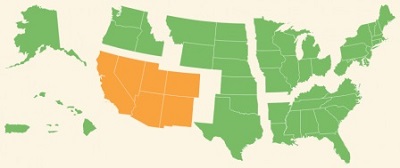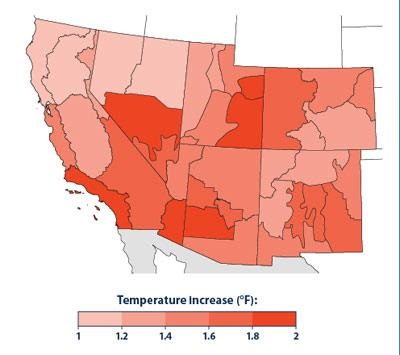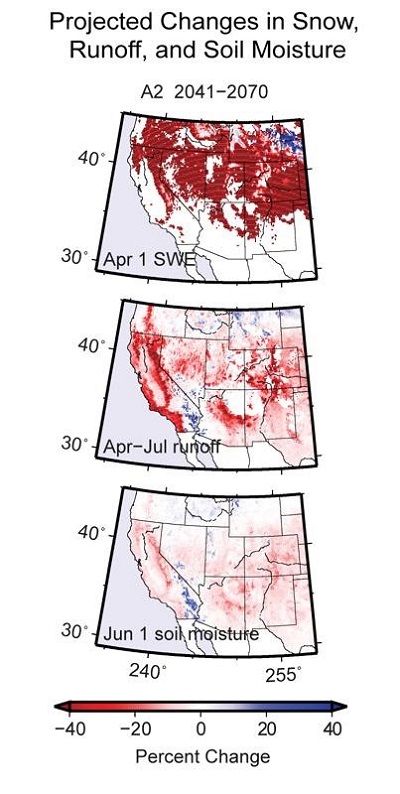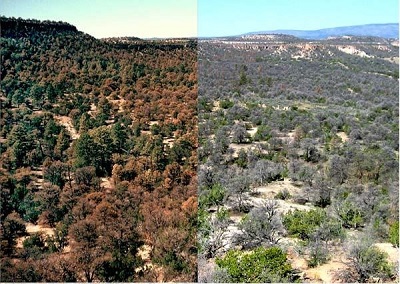|
|
| |
|
|
| |
|
|
|
|
| |
 Climate
Impacts in the Southwest Climate
Impacts in the Southwest
Overview
The Southwest is the hottest and driest region in the
nation. Extending from the Pacific Ocean east to the Rocky
Mountains and south to the Mexican border, this region is
home to about 56 million people, about 90% of whom live in
cities, including Albuquerque, Phoenix, Las Vegas, Salt Lake
City, Denver, San Diego, Los Angeles, Sacramento, and San
Francisco. The population of the Southwest is expected to
increase by nearly 70% by mid-century. The Southwest
encompasses a wide range in elevations, spanning valleys
that are below sea level to mountain ranges that contain
some of the highest peaks in the contiguous United States.
The region’s southern portion includes deserts, like the
Mojave. In contrast, northern California, the Rocky
Mountains, and the Sierra Nevada mountain range tend to get
more precipitation and snow. The Central Valley in
California is one of the most productive agricultural
regions in the country. |
 Climate
change is affecting the Southwest. Temperatures have
increased by almost 2°F in the last century, with the
2001-2010 decade being the warmest since records began 110
years ago. The length of the frost-free season has increased
by 19 days in recent decades. Average annual temperatures
are projected to rise an additional 3.5°F to 9.5°F by the
end of this century, with the greatest temperature increases
expected in the summer and fall. Drought conditions are
already common in the Southwest and drought periods are
expected to become more frequent, intense, and longer.
Drought will affect important water sources, including the
Colorado River Basin. Combined with expected population
growth, climate change will exacerbate existing stresses. Climate
change is affecting the Southwest. Temperatures have
increased by almost 2°F in the last century, with the
2001-2010 decade being the warmest since records began 110
years ago. The length of the frost-free season has increased
by 19 days in recent decades. Average annual temperatures
are projected to rise an additional 3.5°F to 9.5°F by the
end of this century, with the greatest temperature increases
expected in the summer and fall. Drought conditions are
already common in the Southwest and drought periods are
expected to become more frequent, intense, and longer.
Drought will affect important water sources, including the
Colorado River Basin. Combined with expected population
growth, climate change will exacerbate existing stresses.
Picture - Average
temperatures across the entire Southwest have increased in
recent years, with some areas increasing by up to 2°F. This
map shows the average temperature from 2000-2013 relative to
the long-term average from 1895-2013. Source: US EPA (2014) |
|
 Impacts
on Water Resources Impacts
on Water Resources
A reliable water supply is crucial for sustaining the
people, agriculture, energy production, and ecosystems in
this dry region. Increased water demand and reduced water
supplies will add new stresses to already strained water
resources.
Picture - Declines in
snowpack, runoff, and soil moisture are projected to occur
if greenhouse gas emissions remain high. The maps show the
change in conditions between the historic (1971-2000) and
the expected mid-century (2041-2070). Source: USGCRP (2014)
The Southwest relies on the slow melt of mountain snowpack
throughout the spring and summer, when water demands are
highest. Snowpack helps keep the ground and soil moist by
covering it longer into the spring and summer, which delays
the onset of the fire season and influences the prevalence
and severity of wildfires. Over the last 50 years, there has
been less precipitation falling as snow late in the winter
and snow melt has occurred earlier.
Maximum streamflow has also occurred earlier in the year and
total yearly streamflow has decreased in the last decade. In
April 2015, California snowpack held only 5% of the water it
typically holds at this time of year, with some areas having
no snowpack. This was the smallest April snowpack in the
last 65 years, and projections indicate continued declines
in snowpack in the Southwest in the future. In addition to
less snow accumulation, warmer temperatures are expected to
speed snow melting, and rain falling on snow could result in
more rapid runoff and flooding conditions in spring.
Increasing temperatures will also increase evaporation,
causing river-flow reductions and dwindling reservoirs.
Rapid population growth will increase the competition for
water resources across sectors, states, tribes, and even
between the United States and Mexico. Climate change will
likely stress groundwater-based systems and result in
decreased groundwater recharge.
For more information on climate change impacts on water,
please visit the Water Resources page. |
|
|
Impacts on Native Americans
The Southwest is home to 182 federally recognized tribes and
communities. Native Americans already face many challenges
that will be exacerbated by climate change. These
communities face some of the highest poverty rates in the
nation and often lack adequate food, infrastructure,
transportation and access to health and community services.
Some communities, including the Navajo Nation, are already
experiencing drought impacts. Some shallow wells have run
dry and have reduced drinking water supplies. There have
been reported losses of agricultural crops and livestock, as
well as important medicinal and cultural plants and animals.
As climate change impacts worsen, Native American
populations will likely be limited in their ability to
respond to increasing hardships, making them especially
vulnerable.
Impacts on Human Health
In the Southwest, more than 90% of the population live in
cities, the highest percentage of any U.S. region. Pavement
and buildings retain heat, creating urban heat islands that
make cities warmer than surrounding areas and drive
residents’ vulnerability to heat-related illnesses.[6] Heat
stress is the leading cause of weather-related death in the
Southwest, with a greater number of deaths expected as heat
waves increase in number, length, and intensity. Elderly
populations and low income households that may not have
access to air conditioning are especially at risk from heat
stress. High temperatures also contribute to poor air
quality, including the formation of ground-level ozone,
which poses a risk to people with asthma and other
respiratory illnesses.
Health problems are expected to be further aggravated by
disruptions to urban electricity and water supplies. Greater
energy use for cooling during heatwaves is likely to place
additional strain on the electric grid and could result in
brownouts or power outages. Greater water demand in growing
cities and reduced water availability could also affect
access to drinking water.
For more information on climate change impacts on human
health, please visit the Health page. |
|
 Impacts
on Forests and Ecosystems Impacts
on Forests and Ecosystems
Projected increases in drought, wildfire, invasive species,
and pests, as well as changes in the geographic ranges of
species, will likely threaten native forests and other
ecosystems in the Southwest. More severe drought and warming
temperatures are threatening forests in the region and
making them more vulnerable to other stresses, including
pests. Warmer, drier conditions, combined with the
accumulation of dead trees and other fuel have contributed
to an increase in the size of wildfires in recent decades,
resulting in extensive and costly damage. Fire is a natural
occurrence in the Southwest, but excessive wildfire destroys
homes, transforms ecosystems, threatens public health, and
damages the economy. The 2003 Grand Prix fire in southern
California alone caused $1.2 billion in damages.
Picture - Photos taken
from the same vantage point near Los Alamos, New Mexico, in
2002 (left) and in 2004 (right). Source: USGS (2004)
Approximately 40% of the region is estimated to be
vulnerable to changes in the distribution of abundant plant
species as a result of recent and projected climate change.
Fires will likely change the location of forests and other
ecosystems, and changes in climate will likely drive the
migration of species northward or to higher elevations as
species colonize areas with more tolerable climatic
conditions. In California, over 3,000 native plant species
are expected to face reductions in hospitable geographic
range. Iconic species and landscapes, such as that of the
Saguaro cactus in the Sonoran Desert, are also being
threatened.
For more information on climate change impacts on forests,
please visit the Forests page.
To learn more about climate change impacts on ecosystems,
please visit the Ecosystems page. |
|
|
Impacts on Agriculture
California produces more than half the nation’s high-value
specialty crops, including many types of fruits, vegetables,
and nuts. Future production of these crops is likely to be
affected by both reduced water availability and rising
temperatures, resulting in local economic challenges and
increasing food prices across the nation. The majority of
the Southwest utilize irrigated croplands. As the region
continues to become warmer and drier and as the population
grows, more freshwater may be diverted from irrigation use
to urban areas. Warmer temperatures could also result in
more heat waves, a longer frost-free season, and fewer cold
snaps. These changes are likely to cause crops to ripen and
mature early, reducing some crop yields. As climate change
intensifies, a northward shift in agricultural production in
the region could occur.
Livestock production in the Southwest is also expected to be
affected by changes in water availability and temperatures.
Pasture lands are not irrigated, potentially reducing
grazing lands to drought while warming temperatures impose
additional stresses on livestock.
For more information on climate change impacts on
agriculture and food supply, please visit the Agriculture
and Food Supply page. |
|
|
EPA Page |
|
This is the
EPA page for this topic. To see if the Trump
administration has changed the EPA page, simply click the
link and compare the information with this page. If you
notice changes were made to the EPA page, please post a
comment. Thanks. |
|
|
Key Points
Warming temperatures and reduced snowpack have been observed
in recent decades in the Southwest.
Increasing temperatures and more frequent and severe
droughts are expected to heighten competition for water
resources for use in cities, agriculture, and energy
production.
Native communities are expected to experience more
difficulties associated with access to freshwater,
agricultural practices, and declines in medicinal and
cultural plants and animals.
Drought, wildfire, invasive species, pests, and changes in
species' geographic ranges will increase threats to native
forests and ecosystems.
Multiple Climate Stressors and Piñon Pine Die-off
Climate change can intensify multiple stresses that push a
species past a survival threshold. In 2000-2003, the
combination of severe drought and unusually high
temperatures led to a significant die-off of piñon pines in
the Four Corners region of the Southwest. Piñon pines are
very drought tolerant and have survived dry periods in the
past. However, in 2000-2003, high temperatures worsened
drought conditions, making the piñons more susceptible to
pine bark beetle attacks. In some areas, more than 90% of
the piñons died, resulting in major ecosystem changes over a
large area. Warmer winter temperatures are also leading
to worse bark beetle outbreaks because more beetles are able
to survive through the winter and reproduce. |
|
|
|
|
|
|
|
|
|
|
|
|
Additional Climate Change Information |
Climate Change and Carbon Dioxide
(Beginner - Listening,
reading)
A video lesson to
help with your understanding of climate change
and carbon dioxide.
The English is
spoken at 75% of normal speed.
Great English listening and reading practice. |
Carbon Dioxide and Climate Change
(Beginner - Listening,
reading)
A video lesson to
help with your understanding of carbon dioxide
and climate change.
The English is
spoken at 75% of normal speed.
Great English listening and reading practice. |
Environmental Group Warns Earth's Health at Risk
(Beginner - Listening,
reading)
A video lesson to
help with your understanding of climate change.
The English is
spoken at 75% of normal speed.
Great English listening and reading practice.
A report by the World Wildlife Fund looked at thousands of animal populations
and found they have dropped significantly in 40 years. |
Sea Levels Rising at Fastest Rate in 3,000 years
(Beginner - Listening,
reading)
A video lesson to
help with your understanding of climate change.
The English is
spoken at 75% of normal speed.
Great English listening and reading practice.
A group of scientists say sea levels are rising at record rates. Another group
found that January temperatures in the Arctic reached a record high. |
Capturing CO2 Gas Is Not Easy
(Beginner - Listening,
reading)
A video lesson to
help with your understanding of climate change.
The English is
spoken at 75% of normal speed.
Great English listening and reading practice.
Most scientists agree that carbon-dioxide gas is partly to blame for climate
change: rising global temperatures. But capturing the CO2 gas released by power
stations is costly and difficult. |
Growth, Climate Change Threaten African Plants and
Animals
(Beginner - Listening,
reading)
A video lesson to
help with your understanding of climate change.
The English is
spoken at 75% of normal speed.
Great English listening and reading practice.
Researchers believe Africa may lose as much as 30 percent of its animal and
plant species by the end of this century. |
|
|
|
|
Search Fun Easy English |
|
|
|
|
|
|
|
|
|
|
|
|
|
|
|
About
Contact
Copyright
Resources
Site Map |